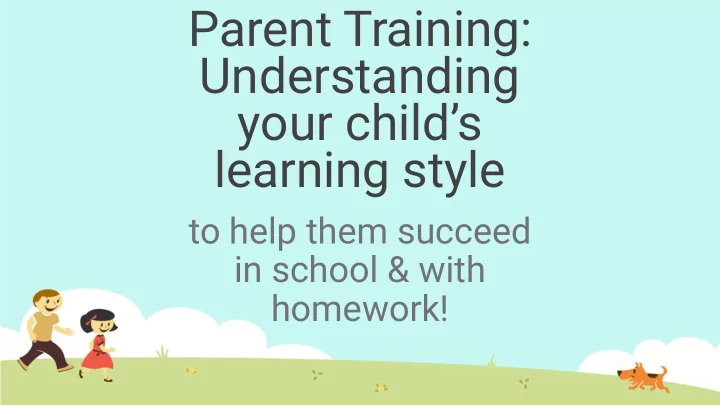

Parent Training: Understanding your child’s learning style to help them succeed in school & with homework!
WELCOME! ❖ Please grab a snack ❖ Find a seat ❖ Begin the “Older Child/Adult Quiz for Learning Styles
best Tracy Wilson, RPS Parent Involvement Coordinator
3 Types of Learning Styles VISUAL Kinesthetic Auditory Learn by seeing information. The hands on learner. Learn by hearing information. Able to remember ❏ learn best by doing or ❏ Able to remember ❏ information presented in working with their hands information explained to pictures, charts, or working with objects or ❏ them diagrams. body movements while can follow spoken ❏ Have strong visualization ❏ studying directions well skills
The Visual Learner
VISUAL CHILD CHARACTERISTICS NEEDS TO SEE TO REMEMBER OR UNDERSTAND LIKES TO READ OFTEN CLOSES EYES TO VISUAL SOMETHING ARE GOOD SPELLERS VALUES PLANNING AND ORGANIZATION TENDS TO BE NEAT IN APPEARANCE NOTICES DETAILS WILL FIND SOMETHING TO WATCH WHEN BORED FORGETS NAMES; Remembers faces HAS TO THINK AWHILE BEFORE UNDERSTANDING LECTURE DREAMS IN COLOR UNDERSTANDS/LIKES CHARTS NEEDS QUIET STUDY TIME GOOD WITH SIGN LANGUAGE LIKES COLORS & FASHION
The Auditory Learner
Auditory Learners can absorb spoken and heard materials easily. They prefer discussion over reading. They enjoy lectures, stories, and songs. Voice inflections and pitch greatly benefit this type of learner. (Gregory & Chapman, 2007)
AUDITORY CHILD CHARACTERISTIC LISTENS WELL -DOES WELL IN LECTURE CLASSES -NOT AFRAID TO SPEAK IN CLASS PREFERS ORAL EXPLANATIONS/ LIKES ORAL REPORTS BENEFITS FROM DISCUSSIONS EASILY DISTRACTED BY NOISE -TALKS TO SELF -READS TO SELF OUT LOUD DISTRACTED BY TOO MUCH VISUAL WILL SEE THE BIG IDEA BEFORE DETAILS
Possible other Auditory Characteristics ➢ Is good at explaining ➢ Remembers names ➢ Notices sound effects in movies ➢ Enjoys music ➢ Is good at grammar and foreign language ➢ Reads slowly ➢ Follows spoken directions well ➢ Can’t keep quiet for long periods ➢ Enjoys acting, being on stage ➢ Is good in study group
The Kinesthetic Learner
Kinesthetic learners learn best by handling materials, writing, drawing, being involved with concrete materials, moving and doing. They need to be involved in activities that are meaningful and relevant. (Gregory & Chapman, 2007)
Kinesthetic Learner Characteristics IS GOOD AT SPORTS CAN’T SIT STILL FOR LONG. IS NOT GREAT AT SPELLING DOES NOT HAVE GREAT HANDWRITING LIKES SCIENCE LAB STUDIES WITH LOUD MUSIC ON LIKES ADVENTURE BOOKS, MOVIES LIKES ROLE PLAYING TAKES BREAKS WHEN STUDYING BUILDS MODELS IS INVOLVED IN MARTIAL ARTS, DANCE IS FIDGETY DURING LECTURES
REMEMBER
Kathy Kennedy, RES Family Engagement Coordinator
HOMEWORK TIPS - VISUAL USE FLASH CARDS WITH ANSWER ON THE BACK USE COLOR AND COLOR CODE WHEN APPROPRIATE FOR SUB-TOPICS USE DIFFERENT COLORS USE YOUTUBE AND VIDEOS ADD DESCRIPTIONS BELOW CHARTS OR PICTURES USE COLOR WHEN WRITING SPELLING OR VOCABULARY WORDS TO AID IN MEMORY USE VISUAL GRAPHIC ORGANIZERS USE PICTURES AND SYMBOLS WHEN TAKING NOTES KEEP AND STUDY HANDOUTS
HOMEWORK TIPS - Auditory YOU CAN TALK TO CHILD ABOUT HOW TO DO SOMETHING - GROUP DISCUSSION USE DOCUMENTARIES ON TV OR YOUTUBE TELL YOUR CHILD HOW TO DO THE TASK ASK PROBING QUESTIONS TO GUIDE LEARNING, READ PASSAGES ALOUD AND SUMMARIZE WHAT WAS READ DO HOMEWORK IN THE QUIETEST PLACE AT HOME DON’T CRITICIZE HIS/HER FOR TALKING TO SELF YOU MAY NEED TO COAX YOUR CHILD TO LOOK AT DETAILS PERHAPS THROUGH ORAL FILL IN THE BLANKS OR QUESTIONING USE RHYMES, RHYTHMS, AND SONGS TO LEARN NEW THINGS
HOMEWORK TIPS - KINESTHETIC STUDYING IN SHORT BLOCKS USE WHITE BOARD AND COLORED MARKERS ROLE PLAYING TAKING FIELD TRIPS, VISITING MUSEUMS STUDYING WITH OTHERS USING MEMORY GAMES USING FLASH CARDS BY THEMSELVES TO MEMORIZE ENCOURAGE FULL BODY MOVEMENT ALLOWING AND INCORPORATING FIDGETING MAKING LEARNING PHYSICAL WORKING ON WHITEBOARDS OR CHALKBOARDS BUILDING OR MAKING MODELS
Recommend
More recommend